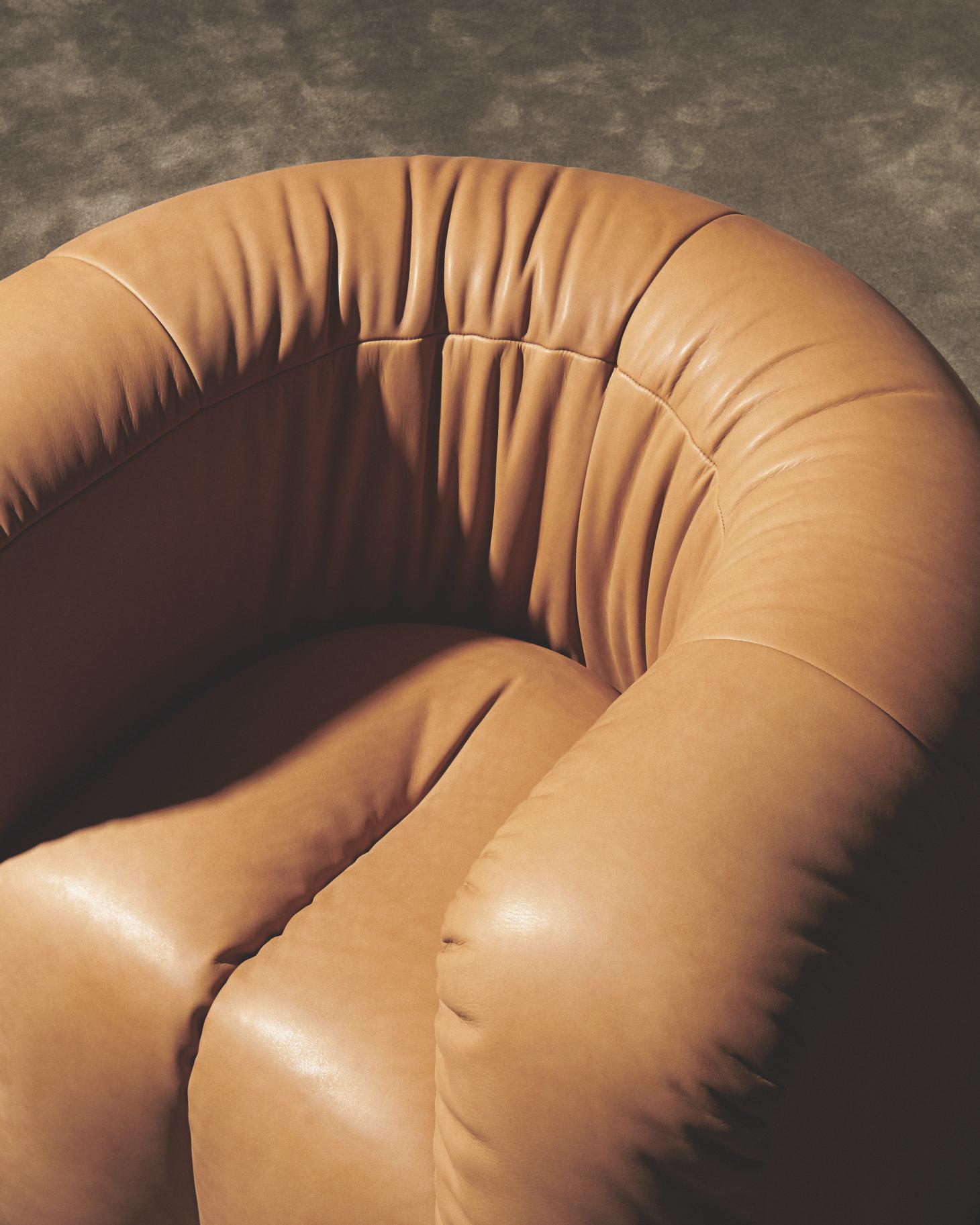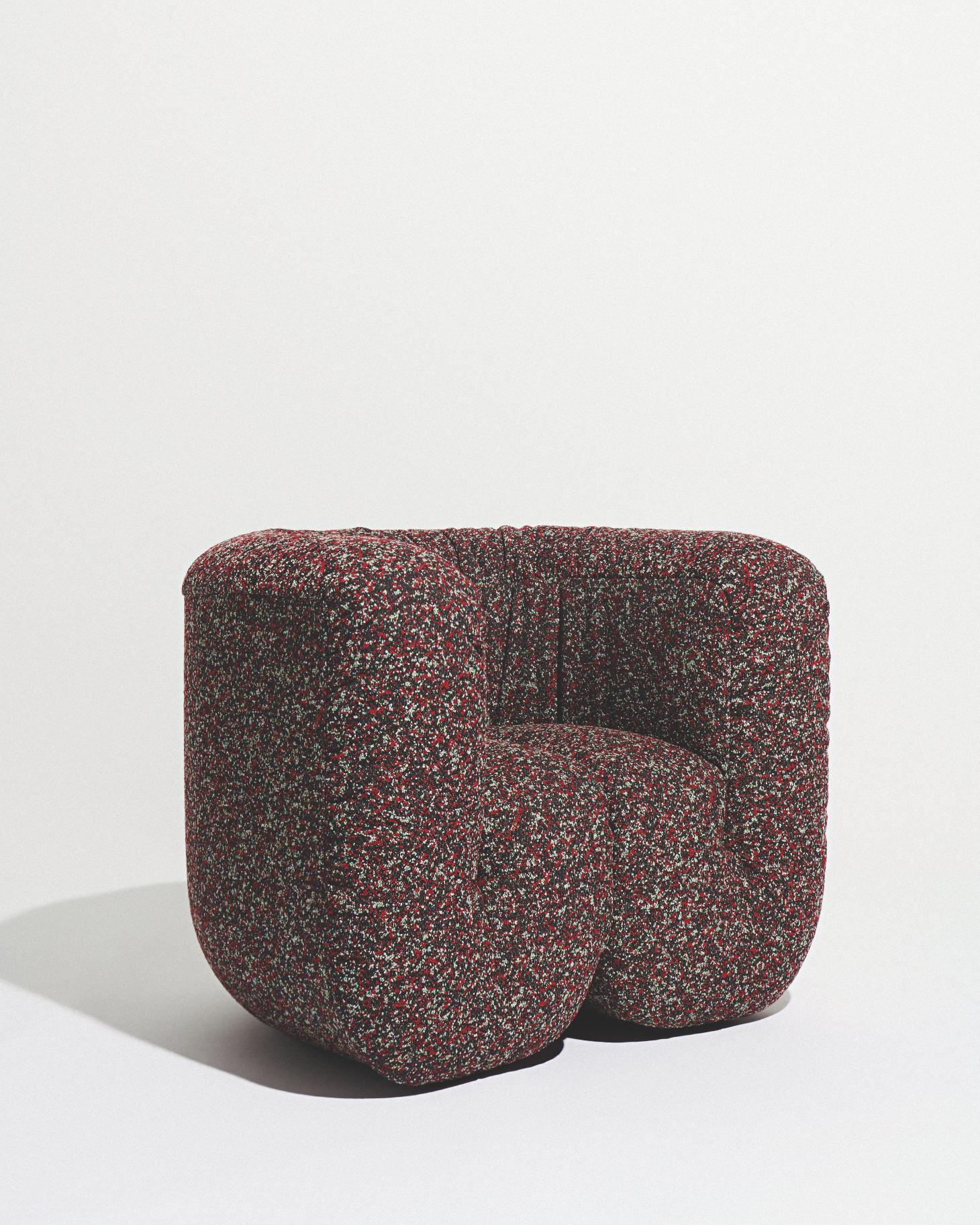Philippe Malouin sofa design for DeSede is a curvaceous marvel
De Sede and Philippe Malouin present the DS-707 family of armchairs and sofas, upholstered in leather or Kvadrat fabrics and created with ‘as little design as possible’
Jonas Marguet - Photography

When designer Philippe Malouin got the call to collaborate with Swiss furniture brand de Sede, his first reaction was surprise, followed by excitement. And then, he freely admits, he began to feel the pressure.

The squeezed form of the ‘DS-707’ armchair, pictured here in Cuoio
De Sede and Philippe Malouin
De Sede began life in 1962 as a small family-run saddler’s workshop, but rapidly grew into a world-class producer of handcrafted leather furniture with a track record for producing coveted modernist design classics, such as the iconic, accordion-like ‘DS-600’ sofa system, Ubald Klug’s terraced ‘DS-1025’ sectional, and the imposing ‘S231’ swivel chair, used as a prop in the 1969 James Bond film On Her Majesty’s Secret Service.
Meanwhile, Malouin’s eponymous studio has racked up an impressive client roster since its founding 12 years ago. Named Wallpaper’s designer of the year in 2018, he has created products for the likes of Iittala, SCP, Kvadrat, Established & Sons, Hem, Ace Hotel and Roll & Hill, to name a few. His interiors studio, Post-Office, has completed spaces for brands such as Aesop, Everlane and Valextra. ‘It takes a long time to be taken seriously,’ he reflects. ‘In the beginning, brands would tell us to jump and we’d ask, “How high?” Now we’re really lucky because we can choose who we work with. De Sede were very willing to let me take the lead, which was great because I had some strong feelings about what we were working on, and they listened.’
A modular sofa born from intuitive material experiments
The brief was straightforward: to create a modular sofa system with a traditional yet contemporary aesthetic. The process began with folded foam experiments, and the resulting form, the ‘DS-707’, was created by taking a square piece of foam and folding it in half and then in half again, which according to Malouin, was the simplest of all of the experiments the studio carried out during the design process.
‘I trained at the Design Academy Eindhoven, so a lot of our work was about experimentation and process, but I also have an industrial design background, so I’m not about making things that can’t be produced,’ he says. ‘I like this method of using foam and I use it a lot when creating upholstery as it produces shapes that a computer can’t give you.’
The tension that makes the chair’s squeezed form so enticing was, perhaps unsurprisingly, the most challenging aspect of its manufacture. De Sede’s craftspeople are more accustomed to avoiding this type of stretch in the leather, so to create it intentionally went against decades of experience. Initially, the team thought it might be impossible to produce as de Sede works with 5mm-thick aniline neck leather, which is very heavy, very solid and virtually bulletproof.
Manufacturing Philipe Malouin's DS-707 sofa and armchair

As well as leather, the system is also available in Atom 574, a coarse bouclé yarn designed by Raf Simons for Kvadrat
‘Neck leather is very hard to manufacture,’ says de Sede designer and product developer Joe Griesbach, who led the project. ‘When I first showed our team of upholsterers Philippe’s prototype, they thought it was never going to work. When you develop a sofa in upholstery, you try not to bend the material, because when you bend it, you lose softness. This project helped to push us out of our comfort zone, to go beyond our knowledge and try unconventional things.’
The ‘DS-707’ system includes an armchair and a modular sofa that can be infinitely extended to create custom configurations. Like much of Malouin’s work, the design appears simple yet mysterious. ‘It has as little design as possible, because if it’s too “designed”, it becomes “trendy”’, he says, ‘and trend is the enemy.’ The armchair’s rounded form possesses an inner construction that allows you to recline, enveloped within its arms; and, when stretched into a sofa, it has shades of de Sede’s classic models.
In addition to the sofa and armchair, the system can be configured so it forms a completely enclosed conversation pit – a distinctly 1970s typology. ‘You have to climb into it, and that’s a totally different experience,’ says Malouin. The system is available in all of the brand’s leather options, as well as a Raf Simons-designed wool upholstery by Kvadrat.
Says Griesbach, ‘Philippe’s work is reminiscent of the Swiss postmodern era. When I first saw it, it was like seeing de Sede’s old design models but translated into a new time.’
INFORMATION
Receive our daily digest of inspiration, escapism and design stories from around the world direct to your inbox.
Ali Morris is a UK-based editor, writer and creative consultant specialising in design, interiors and architecture. In her 16 years as a design writer, Ali has travelled the world, crafting articles about creative projects, products, places and people for titles such as Dezeen, Wallpaper* and Kinfolk.
-
 The Bombardier Global 8000 flies faster and higher to make the most of your time in the air
The Bombardier Global 8000 flies faster and higher to make the most of your time in the airA wellness machine with wings: Bombardier’s new Global 8000 isn’t quite a spa in the sky, but the Canadian manufacturer reckons its flagship business jet will give your health a boost
-
 A former fisherman’s cottage in Brittany is transformed by a new timber extension
A former fisherman’s cottage in Brittany is transformed by a new timber extensionParis-based architects A-platz have woven new elements into the stone fabric of this traditional Breton cottage
-
 New York's members-only boom shows no sign of stopping – and it's about to get even more niche
New York's members-only boom shows no sign of stopping – and it's about to get even more nicheFrom bathing clubs to listening bars, gatekeeping is back in a big way. Here's what's driving the wave of exclusivity
-
 Philippe Malouin designs sculptures that house your personal wares
Philippe Malouin designs sculptures that house your personal waresWorking with a team of master craftsmen, Philippe Malouin creates a range of curved home objects for Finnish brand Iittala, titled Kuru
-
 Modern spirit: the Swiss Institute gives Corbusier icon a millenial twist
Modern spirit: the Swiss Institute gives Corbusier icon a millenial twist